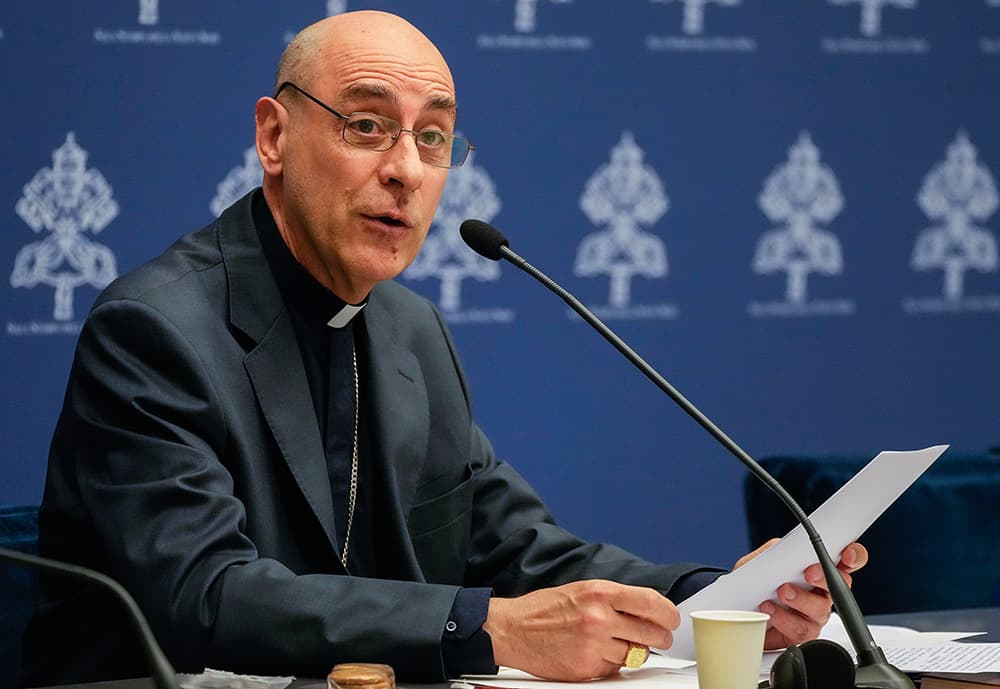The Vatican’s doctrine dicastery published a document on Tuesday strongly discouraging Catholics from referring to the Blessed Virgin Mary as Co-redemptrix, saying “it would not be appropriate to use the title ‘Co-redemptrix to define Mary’s cooperation” in Christ’s work of salvation.
The Dicastery for the Doctrine of the Faith released the document – a Doctrinal Note titled Mater populi fidelis, in English “Mother of the Faithful People” – on Tuesday, Nov. 4. The document is subtitled: “On Some Marian Titles Regarding Mary’s Cooperation in the Work of Salvation.”
It bears the signatures of DDF prefect Cardinal Víctor Manuel Fernández and Secretary for the Doctrinal Section of DDF Msgr. Armando Matteo. Pope Leo XIV approved the publication of the document.
The Co-redemptrix title has been used for several centuries, though it has never been defined dogmatically, and recent popes including both Francis and Benedict XVI – who voted against defining the term when he headed the doctrine office under Pope St. John Paul II, who used the title on different occasions – have been reluctant to adopt it.
Presenting the document on Tuesday, Fernandez expressed appreciation for popular devotion to the Mother of Go but warned against efforts on the part of groups and publications calling for development in the area of the Church’s understanding of Mary’s role in salvation.
The core of Fernandez’s and DDF Note on the question is that the title, Co-redemptrix, adds little to Catholic understanding of the way the Blessed Virgin cooperates with her divine Son’s saving work, while creating confusion and exacerbating misunderstandings.
“This [Co-redemptrix] title,” the Note explains, “risks obscuring Christ’s unique salvific mediation and can therefore create confusion and an imbalance in the harmony of the truths of the Christian faith.”
Quoting the words of Peter as recorded in Chapter 4 of the Acts of the Apostles, the Note says: “[T]here is salvation in no one else,” but Jesus, “for there is no other name under heaven given among men by which we must be saved.”
The Note also addresses other titles, including that of Mediatrix, saying “special prudence is required when applying the term Mediatrix to Mary.”
“Strictly speaking,” the Note continues, “we cannot talk of any other mediation in grace apart from that of the incarnate Son of God.”
“Therefore,” the Note goes on to say, “we must always recall, and never obscure, the Christian conviction that ‘must be firmly believed as a constant element of the Church’s faith’ regarding “the truth of Jesus Christ, Son of God, Lord and only Savior, who through the event of his incarnation, death, and resurrection has brought the history of salvation to fulfillment, and which has in him its fullness and center.”
In his presentation of the Note, Fernandez also noted how expressions of Catholic devotion to Our Lady are ecumenically significant, as well.
“While clarifying in what sense certain titles and expressions referring to Mary are acceptable or not,” Fernandez said, “this text also aims to deepen the proper foundations of Marian devotion by specifying Mary’s place in her relationship with believers in light of the Mystery of Christ as the sole Mediator and Redeemer.”
“This,” Fernandez said, “entails a profound fidelity to Catholic identity while also requiring a particular ecumenical effort.”
“The piety of the faithful People of God — who find in Mary refuge, strength, tenderness, and hope — is not contemplated here to correct it,” Fernandez also said, “but, above all, to appreciate, admire, and encourage it.”















